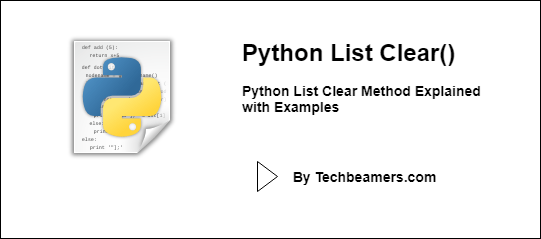From this tutorial, you will learn about the Python list Clear method. You will see how to apply it to sequences with the help of examples.
Note: The syntax used in the below section is for Python 3. You can change it to any other version of Python.
Python List Clear
To Learn about Lists – Read Python List
List Clear Method
The clear() method performs the remove operation on a list and removes all the elements. Its syntax is as follows:
List_name.clear()
After the clear() method gets called, you will get an empty list object. It doesn’t return any value.
How does the Clear() function work?
Numerous alternative techniques exist for effectively emptying a Python list. Nevertheless, the Clear method offers a straightforward means of accomplishing this task.
This method operates without the need for any arguments and efficiently wipes out the entire contents of the list. Subsequently, the list is reset to a pristine, empty state.
Below is a visual representation of the process in the form of a flowchart:

Python’s del method to clear the list
We can achieve the same objective using Python’s del method. It has the following syntax.
del List_name[:]
See this example.
# Initialize a list
listtoclear = [{'a', 'x'}, (1), [3.5, (1, 2)]]
# clearing the list
del listtoclear[:]
print('List after clear():', listtoclear)Below is the output after executing the above code.
List after clear(): []
You can see that the clear() method has better semantics than the del . And, it is a bit easy to use.
List Clear() Method Examples
Clear a list containing numbers:
Fibonacci = [0, 1, 1, 2, 3, 5, 8] Fibonacci.clear() print (Fibonacci)
Output:
[]
Clear a list containing strings:
Linux_distro = ["Ubuntu OS", "Linux Mate OS", "Elementary OS", "Debian OS", "Kali Linux OS"] Linux_distro.clear() print (Linux_distro)
Output:
[]
Clear a list having random values
Random = ["Google", 45, "Dolphin", 23, 21] Random.clear() print (Random)
Output:
[]
Key Facts
Here is a table summarizing some important facts about the list clear() method in Python in point form:
| Fact | Description |
|---|---|
| The list clear() method removes all the elements from a list. | It does not take any arguments and returns no value. |
| The clear() method can be used to empty a list. | This can be useful if you no longer need the elements in the list, or if you want to start fresh with a new list. |
| The clear() method is a destructive method. | This means that it permanently removes the elements from the list. |
| The clear() method can be used on any list, regardless of its size or content. |
Also Read: Add Elements using Python List Insert()
When should be using the list.clear() in Python
Here are some unique examples or problems where the list.clear() method can be useful:
- Clearing a list after you finish using it: This is a good way to avoid memory leaks. A memory leak occurs when you create an object but do not delete it when it is no longer in use. This can cause your program to use more and more memory, eventually leading to a crash.
- Starting fresh with a new list: If you need to start fresh with a new list, you can use the list.clear() method to clear the old list and then create a new one.
- Removing all the elements from a list before you add new elements: This becomes useful if you expect the new elements at the beginning of the list.
- Emptying a list before you delete it: This can be useful if you want to avoid errors. If you delete a list that contains elements, Python will raise an error. By emptying the list first, you can avoid this error.
We hope this helps! Let us know if you have any other questions.
Best,
TechBeamers









